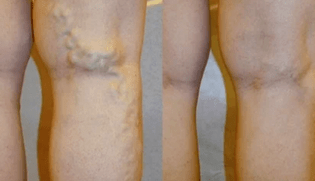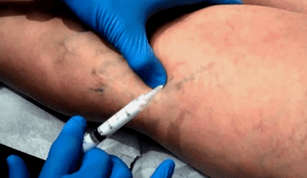According to statistics, varicose veins on the legs in the stronger sex are about 3 times less common than in women. However, everyone, including men, is susceptible to this disease.
According to phlebologists and vascular surgeons, there are no fundamental differences between varicose veins in men and women, but unfortunately, the former seek help much later, when the disease has developed and is much less treatable. The article will focus on the features of the course of the disease in men, as well as the methods of treating it.
The influence of heredity and bad habits on the development of varicose veins
First of all, it is worth understanding that varicose veins or varicose veins in medical practice are called pathology accompanied by deformation of the venous vessels. In this case, the latter expand, stretch, their walls become thinner, and the valve system ceases to cope with its functions. The consequences of the progression of the pathological process are as follows:

- Stagnation of blood in the veins, respectively, increased venous pressure.
- Violation of blood circulation is accompanied by a deterioration in the outflow of lymph.
- Vascular nodules, also called spider veins, appear.
- Vascular rupture and bruising.
- Appearance of trophic ulcers.
- Increased risk of thrombophilia.
By studying the etiology of varicose veins, doctors have concluded that the disease is more likely to develop due to a genetic predisposition. However, the hereditary factor does not concern varicose veins themselves, we are talking about a predisposition to weakness of the valve system, as a result of which the venous valves weaken and wear out faster. This process is the cause of impaired blood circulation in the vascular bed and, as a result, the development of congestion, deformation of the veins, that is, varicose veins.
Also, bad habits, on the list of which smoking and alcohol are in the first place, play an important role in the history of patients. The abuse of tobacco and alcohol products negatively affects the functioning of the cardiovascular system, as well as the condition of the blood vessels and even the composition of the blood. Again referring to the harsh statistics, both habits are more likely to be affected by men, it is this fact that places smoking and alcohol addiction at the top of the list of causes of varicose veins.
However, the two reasons described are not the only ones, there are several more factors that are considered the most probable in the list of causes of the pathology:
- Excessive stress on the legs due to professional activities (cooks, surgeons, etc. ), excess weight, excessive physical exertion due to sports or the same professional activities (loaders, builders, etc. );
- The medal has a disadvantage, varicose veins can be caused by lack of effort, or rather by a sedentary or simply sedentary lifestyle. If we start from this point of view, drivers, office workers, as well as people who, for other reasons, move little, including lack of will, are susceptible to the disease;
- Taking into account the fact of smoking and hereditary predisposition, one of the serious and very common causes are various diseases in which blood coagulation is disturbed.
As for hormonal alterations, the use of uncomfortable shoes and similar factors, they are more inherent in women, for the same reasons (due to the greater number of triggers), the fair sex is more prone to suffering from varicose veins.
The main symptoms of varicose veins
When it comes to the clinical picture of the disease, much depends on the stage of its progression, as well as a number of individual factors and causes of varicose veins. However, there are a number of symptoms that men experience more frequently:

- The early stage of development of varicose veins rarely bothers the patient. There may be slight fatigue in the legs, worse in the evening, pulling or squeezing sensations, slight swelling. In most cases, men do not pay attention to such phenomena and to no avail, as the disease progresses, and over time the symptoms become more pronounced and cause more problems.
- As the disease process progresses, veins begin to appear under the skin. Initially, these are vascular networks and enlarged veins that protrude separately, which are later complemented by vascular "asterisks". The more the disease develops, the more obvious this clinical sign becomes, in the later stages of the development of the disease, the veins bulge under the skin, forming nodules, and the risk of trophic ulcers increases.
- Unpleasant popping sensations, a feeling of heaviness in the legs, as well as swelling, which used to appear in the late afternoon or at the end of the working day, are increasingly being felt. Over time, the unpleasant sensations turn into a systematic pain that spreads along the course of the vessels affected by varicose veins.
- In places where the enlarged veins and vascular mesh are clearly visible, itchy skin appears.
- Cramps, which often affect the foot or calf muscle, can also affect the night.
Important to remember!All the described clinical signs of varicose veins tend to increase at night, but this is precisely due to fatigue. That is, the symptoms become more intense also with greater physical effort.
Stages of venous disease in men
As mentioned above, the symptomatology and, in addition, the health status of the patient and the methods of treating varicose veins, largely depend on the degree of progression of the disease. In total, there are three stages in the development of the pathology:
- Compensatory or mild: in this case, the symptoms are the least intense and the patient himself hardly complains about anything. Already at the first stage, slightly protruding vessels may appear on the legs, but men do not pay attention to this.
- Moderate- This stage of disease development is also called subcompensatory. Veins are most clearly visible on the surface of the skin, but their enlargement and deformation can still be considered negligible, as can the pressure within the vessel. At this stage, other symptoms intensify, edema, fatigue and painful sensations appear for the first time.
- Decompensation stage: the most serious form, the case in which varicose veins reach their peak. They notice severe swelling, intense pain that can bother you throughout the day, the veins strongly protrude on the surface of the skin and change. At this stage, vascular ganglia are formed, excessively increased vascular pressure damages the walls of the veins, and bruises appear. In especially advanced cases, trophic ulcers and eczema occur. At the third stage, conservative methods of treatment are absolutely powerless, the patient needs surgical intervention, the specificity of which is selected by the doctor.

Treatment of varicose veins
As in the case of symptoms, the principles of treatment depend directly on the progression of varicose veins. Here it is important to understand that conservative therapy bears fruit mainly in the first, sometimes in the second stage of the development of the disease; otherwise, conservative treatment methods predominantly restrict the disease, but do not provide an opportunity to completely get rid of varicose veins. However, it is worth considering a wide range of methods of treating the pathology.
Conservative therapy
For treatment with conservative methods, an integrated approach is very important, which mainly involves dietary adjustments and lifestyle changes.
In terms of nutrition, it is important to limit the use of junk food, fatty and fried foods, sweets in large quantities, minimize salty, spicy and acidic foods, since all this contributes to fluid retention in the body andimpairs lymphatic flow.
When it comes to adjusting your lifestyle, you should try to move as much as possible without overloading your legs. Do light sports, walk regularly, if you have to sit a lot at work, warm up every hour. It is also very important to exclude bad habits, stop smoking and limit alcohol consumption as much as possible.
Drug therapy
Without the use of certain drugs, complete treatment is impossible, therefore, when communicating with a phlebologist, a specialist can prescribe drugs of the following groups:
- Anticoagulants: they change the composition of the blood, reducing its viscosity, which improves blood circulation and prevents the formation of stagnation of blood and lymph.
- Venotonics: As the name suggests, drugs in this group improve vascular tone. In turn, it also helps to improve blood circulation, but it is based on a different principle of action.
- As a symptomatic treatment, ointments from the NSAID category are prescribed, which reduce painful sensations and stop the inflammatory process, and also prescribe special ointments for varicose veins, eliminating edema and other symptoms.
- In addition, within the framework of conservative treatment, the use of compression underwear is necessary, it prevents the progression of varicose veins and improves the patient's general condition.
Surgical treatments
If conservative treatment does not give the desired results or the disease has progressed too much, a decision is made about surgical intervention, in this case one of the types of operations is selected:

- Sclerotherapy: A substance (usually in the form of foam) is injected into a vein, which sticks the walls of the vessel and excludes it from circulation. Over time, this vessel removes itself, it is replaced by connective tissue.
- Phlebectomy- a complete operation, during which the anastomosis of a vein is grasped and its affected area is subsequently excised. This method is the most effective and at the same time radical, since it involves an incision, the imposition of words and a long period of rehabilitation.
- Miniflebectomyis a variation of phlebectomy, which is performed mainly on small vessels. A puncture is made in the skin, through which a part of the vein is removed with a special surgical instrument for subsequent dissection. The operation is painless, the puncture heals quickly, and no rehabilitation is required.
- Laser coagulation- A method similar to sclerotherapy, but instead of introducing a special composition into the lumen of a vessel, a thin catheter equipped with a laser is immersed there. The thermal action creates a sclerosis effect, so the vessel is also glued.























